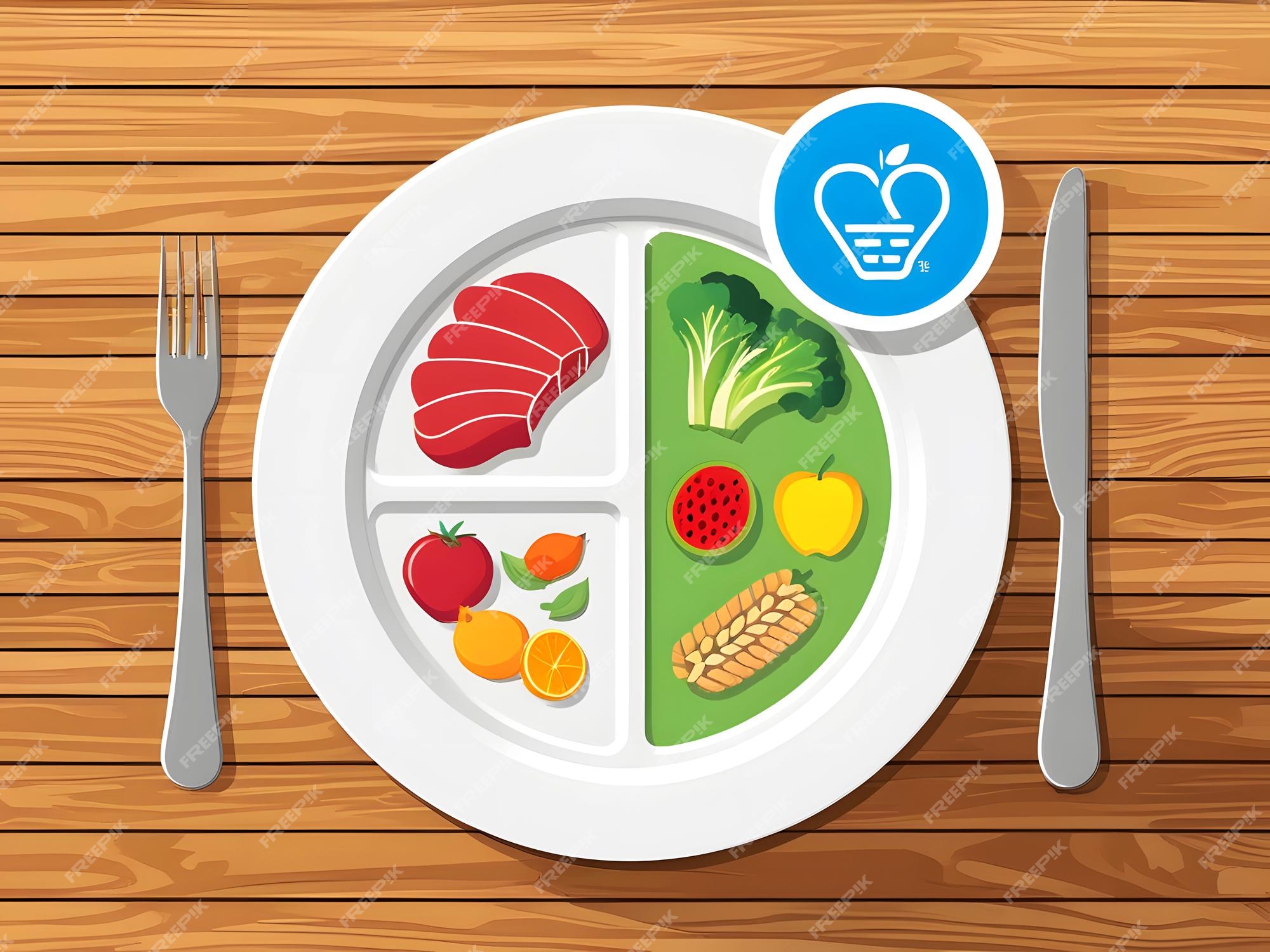
Crafting the Perfect Plate: A Guide to Balanced Meals for Diabetic Health
For individuals managing diabetes, the simple act of eating can feel like navigating a complex maze. Every meal is a decision point, a chance to either support or undermine blood sugar control. But it doesn’t have to be daunting. The key to successful diabetes management lies in understanding how to create a balanced plate for diabetic health. This article provides a comprehensive guide to help you master the art of meal planning, transforming your plate into a powerful tool for wellness.
The core concept is straightforward: build your plate with the right proportions of key food groups. This approach, often referred to as the “plate method,” simplifies meal planning and makes it easier to visualize and control portion sizes. By focusing on a balanced plate for diabetic health, you can effectively manage blood sugar levels, reduce the risk of complications, and improve your overall quality of life.
Understanding the Foundation: Carbohydrates, Proteins, and Fats
Before diving into the plate method, it’s crucial to understand the roles of the macronutrients: carbohydrates, proteins, and fats. Each plays a vital role in your body, and their balance is particularly important for people with diabetes.
- Carbohydrates: These are your body’s primary energy source. They break down into glucose, which the body uses for fuel. However, carbohydrates also have the most significant impact on blood sugar levels. Choosing the right types and controlling portion sizes are essential.
- Proteins: Proteins are the building blocks of your body, essential for repairing and maintaining tissues. They have a slower impact on blood sugar than carbohydrates and contribute to satiety.
- Fats: Fats provide energy and support various bodily functions. Healthy fats are crucial for overall health, but it’s important to choose the right types and consume them in moderation.
The Plate Method: A Practical Approach
The plate method is a visual guide for creating a balanced plate for diabetic health. It’s a simple yet effective way to manage portion sizes and ensure you’re getting the right balance of nutrients at each meal. Here’s how it works:
- Divide your plate: Imagine your plate is divided into three sections.
- Fill half the plate with non-starchy vegetables: These include vegetables like broccoli, spinach, carrots, and peppers. They are low in carbohydrates and high in fiber, vitamins, and minerals.
- Fill one-quarter of the plate with lean protein: Choose protein sources like grilled chicken or fish, tofu, beans, or lean cuts of meat.
- Fill one-quarter of the plate with carbohydrate-rich foods: Opt for whole grains like brown rice or quinoa, starchy vegetables like sweet potatoes, or a serving of fruit.
- Add a serving of healthy fats: This could include a tablespoon of olive oil, a small handful of nuts, or avocado.
- Consider a side of fruit or dairy: These can supplement your meal, but be mindful of portion sizes to manage carbohydrate intake.
Non-Starchy Vegetables: The Cornerstone of a Balanced Plate
Non-starchy vegetables are the stars of a balanced plate for diabetic health. They’re low in calories and carbohydrates while being packed with fiber, vitamins, and minerals. They also help you feel full and satisfied, which can aid in weight management.
Examples of excellent non-starchy vegetables include:
- Leafy greens: spinach, kale, lettuce
- Cruciferous vegetables: broccoli, cauliflower, Brussels sprouts
- Other vegetables: carrots, bell peppers, mushrooms, onions, tomatoes
Feel free to experiment with different cooking methods, such as steaming, roasting, or grilling, to enhance the flavor and variety of your meals. Aim to fill half your plate with these nutrient-rich choices.
Choosing Protein: The Building Blocks of a Healthy Diet
Protein is essential for building and repairing tissues, and it plays a key role in satiety. When creating a balanced plate for diabetic health, choose lean protein sources to help manage blood sugar levels and promote overall health.
Good protein choices include:
- Lean meats: chicken breast, turkey breast, lean cuts of beef
- Fish: salmon, tuna, cod (rich in omega-3 fatty acids)
- Plant-based proteins: tofu, tempeh, beans, lentils
- Eggs: a versatile and affordable protein source
Be mindful of portion sizes and cooking methods. Opt for grilling, baking, or steaming instead of frying. Remove the skin from poultry to reduce fat intake. Aim to fill one-quarter of your plate with protein.
Carbohydrates: Making Smart Choices
Carbohydrates have the most significant impact on blood sugar levels. For a balanced plate for diabetic health, it’s crucial to choose carbohydrate sources wisely and control portion sizes. Focus on whole grains, starchy vegetables, and fruits over refined carbohydrates.
Examples of healthier carbohydrate choices include:
- Whole grains: brown rice, quinoa, oats
- Starchy vegetables: sweet potatoes, corn, peas
- Fruits: berries, apples, oranges (in moderation)
- Beans and lentils: a good source of both carbohydrates and protein
Limit refined carbohydrates like white bread, white rice, pasta, and sugary drinks. These foods can cause rapid spikes in blood sugar levels. Fill one-quarter of your plate with your chosen carbohydrate source, and monitor your blood sugar levels to understand how different foods affect you.
Healthy Fats: Essential for Overall Well-being
Healthy fats are essential for various bodily functions. They also contribute to satiety. Incorporating healthy fats into your balanced plate for diabetic health is important, but moderation is key.
Good sources of healthy fats include:
- Avocados
- Nuts and seeds (e.g., almonds, walnuts, chia seeds)
- Olive oil
- Fatty fish (e.g., salmon, tuna)
Limit saturated and trans fats found in processed foods, fried foods, and some animal products. Add a small amount of healthy fats to your meals, such as a tablespoon of olive oil or a handful of nuts.
Meal Planning Tips for Success
Creating a balanced plate for diabetic health is easier when you have a plan. Here are some tips to help you succeed:
- Plan your meals: Take time each week to plan your meals. This helps you make healthier choices and avoid impulsive decisions.
- Shop smart: Create a shopping list based on your meal plan and stick to it. Focus on whole, unprocessed foods.
- Prepare meals in advance: Cook meals or components of meals ahead of time to save time during the week.
- Read food labels: Pay attention to serving sizes, carbohydrate content, and other nutritional information.
- Track your blood sugar levels: Monitor your blood sugar levels before and after meals to understand how different foods affect you.
- Consult a healthcare professional: Work with a registered dietitian or certified diabetes educator to create a personalized meal plan that meets your individual needs.
Beyond the Plate: Lifestyle Factors for Diabetes Management
While a balanced plate for diabetic health is crucial, it’s only one piece of the puzzle. Other lifestyle factors also play a significant role in managing diabetes.
- Physical activity: Regular exercise helps improve insulin sensitivity and blood sugar control. Aim for at least 150 minutes of moderate-intensity exercise per week.
- Weight management: Maintaining a healthy weight can improve blood sugar control and reduce the risk of diabetes complications.
- Stress management: Chronic stress can raise blood sugar levels. Practice relaxation techniques like deep breathing, meditation, or yoga.
- Medication adherence: Take your diabetes medications as prescribed by your doctor.
- Regular check-ups: Attend regular check-ups with your healthcare team to monitor your health and make adjustments to your treatment plan as needed.
Putting It All Together: A Sample Meal Plan
Here’s a sample meal plan to illustrate how to create a balanced plate for diabetic health. Remember to adjust portion sizes and food choices to meet your individual needs and preferences.
Breakfast:
- Oatmeal (1/2 cup) with berries (1/2 cup) and a handful of nuts
- Greek yogurt (1 cup)
Lunch:
- Grilled chicken salad with mixed greens, non-starchy vegetables, and a light vinaigrette
- Small whole-wheat roll
Dinner:
- Baked salmon (3-4 ounces)
- Roasted sweet potatoes (1/2 cup)
- Steamed broccoli (1 cup)
- Side salad with olive oil and vinegar
Snacks (optional):
- Apple slices with peanut butter
- A handful of almonds
- Vegetable sticks with hummus
This is just a sample. The best meal plan for you will be one you can stick to consistently. Consider consulting a registered dietitian to create a plan tailored to your specific needs. Remember, the goal is to build a balanced plate for diabetic health that supports your overall well-being.
Conclusion: Taking Control of Your Health
Managing diabetes effectively requires a multifaceted approach. At the heart of this approach is learning how to create a balanced plate for diabetic health. By understanding the roles of carbohydrates, proteins, and fats, and by using the plate method as a guide, you can take control of your meals and, ultimately, your health. Remember to focus on whole, unprocessed foods, control portion sizes, and incorporate regular physical activity and other healthy lifestyle habits. With dedication and the right knowledge, you can live a full and vibrant life while managing diabetes successfully. Building a balanced plate for diabetic health is an investment in your future, empowering you to make informed choices and take charge of your well-being. [See also: Related Article Titles]

